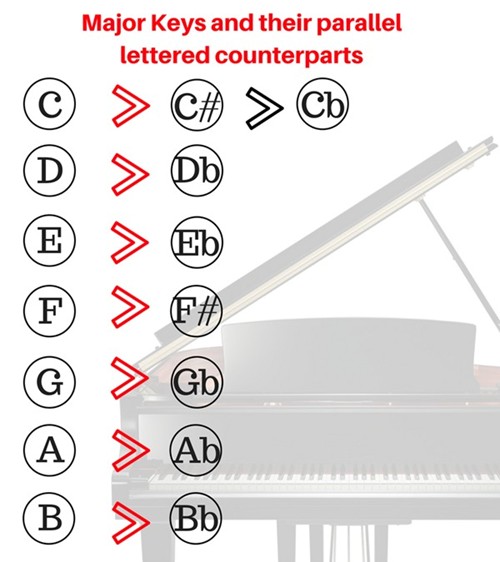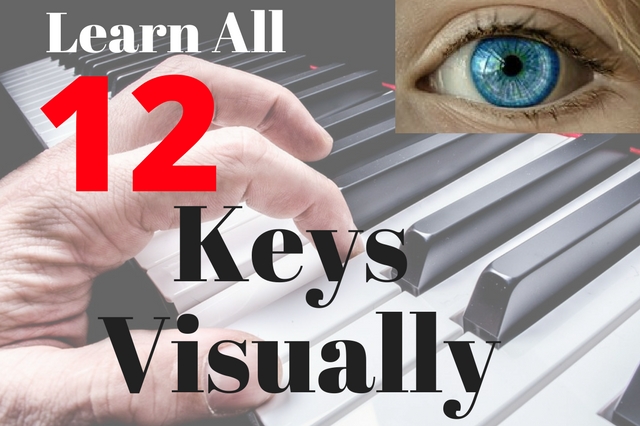I want to share with you a visual way to learn all 12 major keys of music on the piano. I believe that any concept about playing the piano can be taught visually. This article about visually learning all 12 major keys on the piano is no exception.
Well, which one is it, Key’s or Scales? I’ve been often asked what the difference is between the two. The short answer is that they’re one in the same. If I’m playing a piece of music, whether It’s a song or just improvising a random chord progression, the notes and chords that I’m playing are going to have a tonal center. This is also known as the tonic which is the key of music that it’s named after. For example, if I’m playing a song with the tonal center of C, that’s the key of music that I’m playing in.
chords that I’m playing are going to have a tonal center. This is also known as the tonic which is the key of music that it’s named after. For example, if I’m playing a song with the tonal center of C, that’s the key of music that I’m playing in.
Playing the notes of a given scale implies that you’re also playing that of the same key. You can however, be playing in a key of music and play notes that are of a different scale without actually changing the key you’re in. But most of these notes are often the same ones of the key. I prefer the term “key of music” simply because the word scale implies hours pointless study and boredom.
But whatever you decide to call them, it will make your life a lot easier to know them very well. So I want to show you a visual way to learn all 12 major keys of music on the piano. And in case you’re not aware of it, keys of music (or scales) are the raw materials for chords. Learn them and you have endless possibilities for chords and voicings.
First, realize that every major key of music contains the first 7 letters of the alphabet.
A B C D E F G
The only difference between them is that they don’t all appear in the same sequence. For example, the key of C Major starts on C and proceeds up from there.
The key of F Major starts on F and proceeds.

Notice that the B is flat. That leads me to my next point.
With the exception of the key of C Major, all other Major keys of music have one or more flats in them. Or, they have one or more sharps in them. Sharps and flats are referred to as accidentals in music. And as far as keyboard playing is concerned, they will land on the black Keys. As you progress through keys that have many sharps or flats, you will find that some of those accidentals will land on white keys.
But it’s not that many of them. That’s often a daunting statistic for most beginning piano students. It seems as though there’s a world of keys of music and it’s an insurmountable task to learn them all. But I’m going to show you in a visual way that’s not the case. This really is about learning all 12 Major keys on the piano visually.
Like I said earlier, all 12 Major keys of music contain the first 7 letters of the alphabet and the presence of sharps or flats do not change that fact.
Here are a few examples.
Key of D Major
Key of B flat Major

Key of G Major

Let me ask you: Are there any notes represented that do not contain the first 7 letters of the alphabet?
This is an important distinction that not every beginning piano player understands. What will often cause confusion is when someone calls out the note names of a key of music incorrectly by skipping a letter and naming a letter twice.
Let me ask you: Are there any keys represented that do not contain the first 7 letters of the alphabet?
This is an important distinction that not every beginning piano player understands. What will often cause confusion is when someone calls out the note names of a key of music incorrectly by skipping a letter and naming a letter twice.
An example of this would be the key of G flat Major.

Notice that the 4th tone in the key is on what appears to be a B natural. But if you refer to it as a B and proceed upward, you’ll notice that you’ve skipped C all together. You can’t have two B’s in a key of music even if one of them is flat. You must have only one of each letter. In this context, the note commonly known as B is a C flat.
Also, sharps and flats are never mixed together. You either have flats or sharps in a key of music, but never both sharps and flats. For example, notice the 4th tone in the key of D flat Major:

A musician who doesn’t understand this concept will often refer to the G flat as an F sharp.
Please realize that I’m not just talking about technicalities and following musical rules that don’t have any real purpose. In order to visually learn all 12 Major keys of music on the piano, you have to understand how the structure of notes apply to all 12 keys. The letter names of notes tie directly into how to do just that.
Let’s recap the points we’ve covered about Major keys of music so far:
- There’s 7 different notes in a Major key of music
- Each note in a Major key of music is named after the first 7 letters of the alphabet
- Those letters are in different sequences
- With the exception of C Major, all Major keys of music contain either sharps or flats
- Sharps and flats are never mixed together in a Major key of music
So here is a very interesting observation: If you completely ignore sharps and flats (just for the moment), there’s actually only 6 Major keys of music instead of 12.
Let’s take the simplest example of a Major key of Music: the key of C Major

Now let’s look at the key of C sharp Major. But, DON’T LOOK AT THE SHARPS. Just look at the note letters only.

Do I have to point out that each lettered note sequence is identical? I’m sure you noticed it. Every Major key of music has a parallel key with an identical lettered note sequence. Be aware, I’m not talking about a parallel minor key where one is Major and the other is minor. I’m referring to 2 parallel keys of music that are both Major.
Let’s look at two more of them.
Here’s the key of G Major:

Here’s its parallel lettered key of G flat Major:

Again, you have the same lettered notes in each key. You should also be aware that when you have natural notes (notes without sharps or flats) it’s parallel lettered key will represent those same notes as being sharp or flat and vice versa.
Here’s the key of F Major:

Notice that the B in F Major is flat.
Now look at the key of F Sharp Major.

The B in the key of F Sharp Major is natural.
You may have also noticed that these parallel lettered keys are very different from one another in appearance. There will always be more notes on black keys in one of them.

Now that we’ve established the parallel letter concept, how can you visually learn all 12 Major keys of music?
First, understand that every Major keys of music has a distinctive visual characteristic that is unique and unlike any another. The goal of learning all 12 Major keys of music is to know them so well that you easily see them in your minds eye. And if you can see them in your minds eye, you can recall them quickly and easily.
Let me first give you a couple of don’t do’s.
- Don’t read/study them from the treble clef on a piece of sheet music. This isn’t visual. You’re having to translate the dots to the keyboard and then you’re having to locate the corresponding keys.
- Don’t use your whole hand to play each note in the key. What happens is that your kinesthetic sense (physical memory) takes over and your subconscious mind is finding the correct notes in the key. The problem with this approach is that your hand learns to play the correct notes at the keyboard, but you can’t recall what the specific notes are unless your hand is in that environment.
You must to know the notes and the number sequence consciously. Having this knowledge about the notes in a Major key of music gives you the tools to create satisfying chords and voicings.
Here are the do’s.
- Take one (1) finger (preferably your right hand) and start on the first note in the key and count from 1 to 7 as you ascend up the key. You can end on the first tone an octave higher. Descend down the key as you count from 7 to 1.
- Play the notes in an even pace as you ascend and descend through the key.
- Notice the visual characteristics of each key that you study. (example: 2 black keys then 1 white key etc
Now to help you further understand the letter relationship of each Major key, I’m going to group them together with Keyshots that correspond with the same letter sequence.
We’ll start with keys that begin with the note C. It just so happens that there’s actually 3 different keys in his group simply because of the nature of this key.



If you’re thinking that the key of C sharp looks just like D flat and C flat looks just like B, you would be correct. These are enharmonic keys which means they have the same notes as their counterparts but have different note names.
The key of D and D flat Major


As I mentioned earlier, the key of D flat Major and C sharp Major are the same exact notes with different note names.
The Key of E and E flat Major


The key of F and F sharp Major

The key of G and G flat Major


The key of A and A flat Major


The Key of B and B flat Major


In this article we’ve defined a key of music, accidentals, parallel letter relationship, enharmonic keys and visual characteristics. As I stated earlier, it’s an absolute necessity to learn all 12 major keys in order to build any type of chords and voicings.
Now that you have a comprehensive understanding of Major keys of music, spend the time and effort to learn them. In order to learn all 12 Major keys visually, you have to study them with enough repetition to be able to visualize them when you’re not in front of the keyboard.
When you can recite them from memory by recalling them visually in your mind, you’ve learned all 12 Major keys of music. And you’ve learned them the best way possible. You’ve visually learned all 12 Major keys of music.
Until Next time, Go Play.
Greg Lee
Latest posts by Greg Lee (see all)
- What is a minor/Major 7 Chord? - October 26, 2023
- 7 Chord Substitutions that Professionals Use - October 19, 2023
- 5 Simple Chord Tricks to Sound Amazing - October 5, 2023





